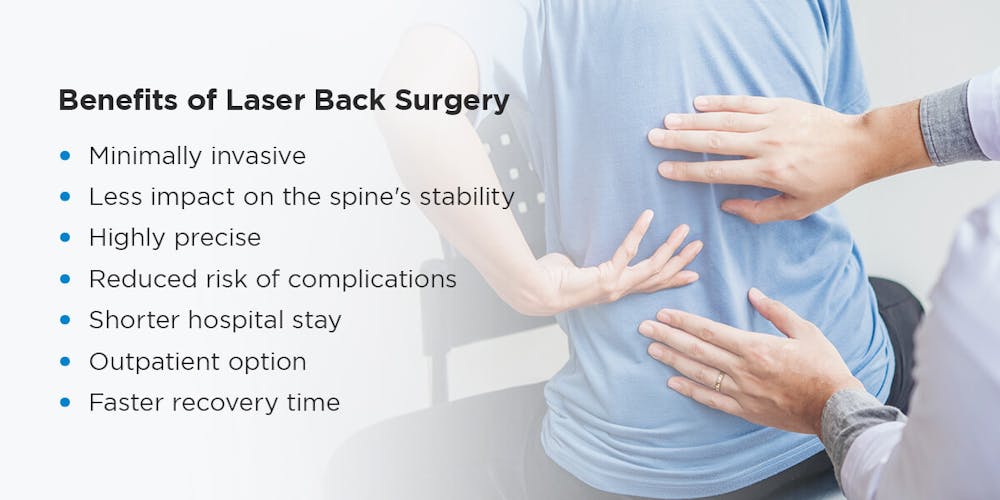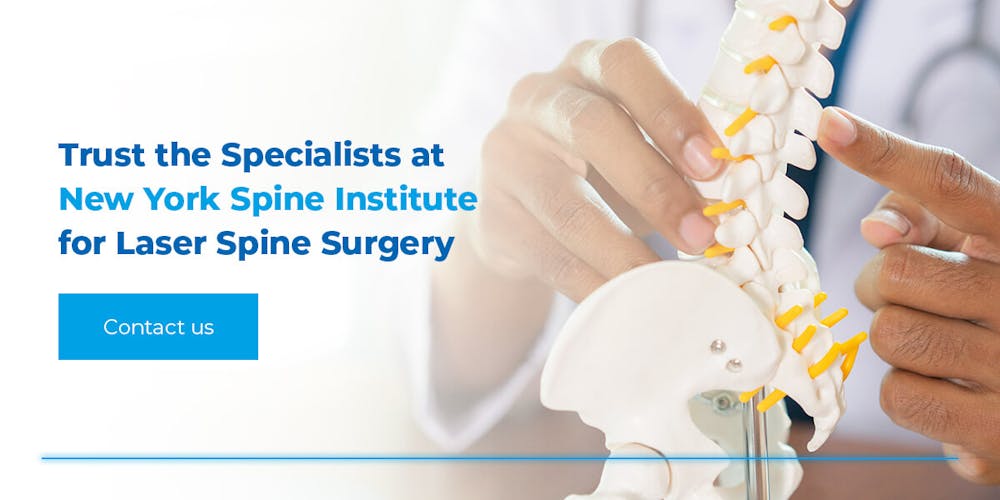
Back pain is a common yet frustrating ailment that can diminish your quality of life. While several treatment options are available, laser spine surgery has recently gained popularity. If you’ve tried countless back pain treatment methods without finding relief, you may want to ask your doctor if this procedure is right for you.
Laser back surgery can treat some spinal concerns when nonsurgical options haven’t worked. This method involves a minimally invasive surgical procedure that can effectively treat certain spinal conditions with less pain and scarring than traditional open surgery. It also offers a faster recovery time.
If you’re ready to learn more about this innovative treatment procedure for spinal pain, read on to discover which conditions it treats, what the process is like and how it can benefit you.
What Can Laser Spine Surgery Treat?
While laser back surgery is a minimally invasive procedure that can treat many types of back pain, it won’t work for all conditions, particularly severe or complex problems. Laser spine surgery is most effective for patients with the following spinal concerns:
- Spinal cord tumors: Spinal cord tumors are abnormal growths or masses of cells that form within or around the spinal cord or spinal column. Whether cancerous or noncancerous, these tumors can cause pain and discomfort when they compress the spinal cord or nerves.
- Pinched nerves: Pinched nerves occur when the surrounding bones, cartilage, muscles or tendons apply too much pressure to the nerve. This pressure can cause pain, tingling, numbness or weakness in the affected area. Symptoms may also radiate down the nerve path, causing pain in other areas away from the actual site.
- Herniated discs: Herniated discs occur when the soft inner portion of a spinal disc pushes through a crack in the tougher exterior layer and presses on a nearby nerve root. This can cause pain, numbness or weakness in the area of the body served by that nerve. Herniated discs can occur in any part of the spine but most commonly affect the neck and lower back.
- Sciatica: Sciatica is a condition in which pain travels down the sciatic nerve’s path, which starts in the lower back and runs down one or both legs. Sciatica is commonly caused by a slipped or herniated spinal disc that presses on the nerve, resulting in pain, weakness or numbness in the afflicted area.
- Spinal stenosis: Spinal stenosis occurs when the spaces within the spine narrow, putting pressure on the spinal cord and nerves that travel through the spine. This pressure can cause pain, numbness or weakness in the affected area. Spinal stenosis most commonly occurs in the lower back and the neck.
- Disc degeneration: Spinal disc degeneration is a condition where the spinal discs, which act as shock absorbers between the vertebrae, start to break down and deteriorate over time. A common part of aging, disc degeneration can result in back pain, stiffness and reduced mobility.
The Process of Laser Back Surgery
During laser back surgery, the patient is typically placed under general anesthesia so they feel no pain and have no awareness of the procedure. The surgeon then makes a small cut in the skin and inserts a small tube, called a cannula, into the affected area of the spine. The surgeon uses the cannula to guide a laser fiber into the spine, which vaporizes or ablates the damaged tissue or bone. The surgeon then removes the bone fragments or tissue debris through the cannula.
Once laser back surgery is complete, the patient will typically spend a short time in the recovery room before transferring to a hospital room or being discharged home. Most patients are able to resume normal activities within a few days to a few weeks, depending on the specific procedure and the patient’s individual recovery time.
Benefits of Laser Back Surgery

Laser spine treatment offers several benefits over traditional open surgery, including the following:
- Minimally invasive: Laser back surgery requires only a small incision, typically less than an inch, which results in less pain and scarring and a faster recovery time for the patient. Traditional open surgery requires a larger incision and can cause more damage to surrounding tissues.
- Less impact on the spine’s stability: Traditional back surgeries that drill into the bone can weaken and destabilize the spine, resulting in potential complications that may require a more invasive fix. Laser spine surgery involves no drilling, so there’s minimal impact on spine stability.
- Highly precise: The laser used in laser back surgery is highly precise, and surgeons can adjust it to target only the damaged tissue or bone, leaving healthy tissue intact. This precision allows for more effective treatment with fewer risks and complications than traditional open surgery.
- Reduced risk of complications: A smaller incision means the surgical site receives less exposure to outside contaminants, meaning there’s less risk of infection. And because laser back surgery is minimally invasive, there’s less risk of blood loss and potential muscle and soft tissue injury compared to traditional spine surgery.
- Shorter hospital stay: Patients who undergo laser back surgery typically have a shorter hospital stay than those who undergo conventional back surgery because the procedure is less invasive and requires less recovery time.
- Outpatient option: Some patients can undergo laser spine surgery under local anesthesia in an outpatient setting. These patients are able to go home the same day as their surgery and recover in the comfort of their homes. This also reduces the procedure cost since there’s no need for an extended hospital stay.
- Faster recovery time: Laser back surgery typically has a quicker recovery time than traditional open surgery. Most patients are able to return to normal activities within a few days to a few weeks, depending on the specific procedure and the patient’s individual recovery time.
Trust the Specialists at New York Spine Institute for Laser Spine Surgery

Laser spine surgery offers many benefits to patients suffering from spinal issues. It’s minimally invasive, outpatient-appropriate and highly precise, making it an attractive option for people seeking relief from back pain and other spinal symptoms.
The New York Spine Institute specializes in diagnosing and treating spinal conditions. We offer diagnostics and medical treatments for many spinal problems, including spinal disorders and complex adult and pediatric issues. Our team of experts includes orthopedic spine surgeons, neurosurgeons, physiatrists and pain management specialists who work together to provide personalized care for each patient.
If you’re considering laser spine surgery in NYC, contact the New York Spine Institute for a free consultation with one of our specialists at one of our many New York-area locations. We look forward to helping you find relief from back pain and a better quality of life.
Linked Sources
- https://www.nyspine.com/services/orthopedic-division/low-back-pain/
- https://www.nyspine.com/blog/types-of-spinal-tumors/
- https://www.nyspine.com/services/orthopedic-division/tumors-of-the-spine/
- https://www.nyspine.com/services/orthopedic-division/spine-conditions-herniated-disc/
- https://www.nyspine.com/services/orthopedic-division/sciatica/
- https://www.nyspine.com/services/orthopedic-division/spinal-stenosis/
- https://www.nyspine.com/services/orthopedic-division/spine-conditions-degenerative-disc-disease/
- https://www.nyspine.com/schedule-an-appointment/
